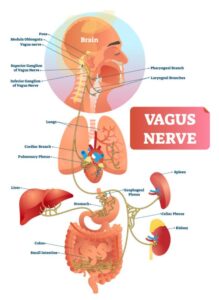What options are there for vertigo surgery, and is surgery a viable vertigo treatment option? When other forms of treatment aren’t effective in relieving vertigo symptoms, surgery may be considered. The type of surgery recommended depends upon the individual’s diagnosis and physical condition. Over the years as microsurgery advances, vertigo disorders such as Ménière’s disease, chronic labyrinthitis, benign positional vertigo, and vestibular neuronitis have shown to be curable through surgical means.
Meniere’s Disease Surgery
Early on in this disease, holistic treatments can prove effective. As the disease progresses and in extreme cases, vertigo surgery may be recommended.
Endolymphatic shunt
An endolymphatic shunt placement is used to drain excess fluid from the inner ear. It is performed under general anesthesia and takes about an hour to complete the surgery. For the procedure, an incision will be made behind the ear, and the plastic shunt tube is placed into the endolymphatic sac of the inner ear. From there, the shunt allows excess inner ear fluid to drain into the cavity behind the ear.
While very few cases can result in permanent hearing loss in the affected ear, it is still important to realize that it is a possibility. There are several other side effects such as bleeding, infection, CSF leak, dizziness, facial paralysis, and failure to achieve improvement in the disabling vertigo.
Vestibular Neurectomy
This procedure may be advised when hearing is good in the affected ear. It is an operation to cut the balance nerve while also preserving the
hearing nerve from the ear to the brain. The operation is done through the mastoid bone behind the ear or through an opening in the skull. A portion of the bone is removed and the balance nerve is cut. It is also performed under general anesthesia, however the recovery time usually requires from a few days to a week of hospitalization.
While 93 – 95% of patients find relief through this method, a small percentage still suffer worsened or permanent hearing loss. Even successful surgeries can lead patients to feeling unsteadiness for weeks or even months until the opposite ear stabilizes the balance system.
Labyrinthectomy
This is a surgical procedure that is performed to treat vertigo in an affected ear that has little hearing ability, and is often used as a last resort treatment. This treatment is performed in a hospital under general anesthesia. It is performed with one of two possible approaches. A transcanal approach is less invasive but may not provide full results, or a transmastoid approach which is the more common method.
As stated before, a labyrinthectomy is considered a last resort and comes with several risks such as imbalance, infection, headaches, numbness, altered taste, damage to facial nerves, or leaking of cerebrospinal fluid.
BPPV Surgery
About 95% of sufferers of BPPV (benign paroxysmal positional vertigo) will find relief of their vertigo with time and conservative treatments. However, there is a small percentage that do not find relief through these methods alone, this is when surgery may be recommended.
Canal Plugging
A canal plugging procedure is one such surgery that could be recommended. A craniotomy is used for this procedure to get to the inner ear organs to create a hole in the canal. That hole is then filled with small bone chips and human fibrinogen glue. This is meant to block most of the posterior canal’s function without affecting the functions of the other canals or parts of the ear. The risk of hearing loss is substantial with 3-20% of patients experiencing worsened or complete hearing loss.
Microvascular Decompression
This type of surgery is thought to be able to treat positional vertigo that has originated in the vestibular nerve. It is done under general anesthesia and an incision behind the ear is made and a small piece of bone is removed to get to the nerves. The risks involved are similar to the other surgeries listed, which includes hearing loss, facial numbness, difficulty with speech, and in extreme cases, stroke or hemorrhage.

Why Vertigo Surgery Is A Bad Idea
Vertigo surgery carries significant risk for complications, just like any other surgery does. Vertigo can be treated in a multitude of ways that are non-invasive and do not put you at risk for permanent damage to your hearing or balance system. If you’ve experienced vertigo, I recommend downloading my 5-steps to get out of the vertigo spins. It could lead you to finding relief from vertigo without the need for drugs or surgeries. I have many resources for individuals suffering with vertigo and have no idea where to look to find a cure. If you’re considering vertigo surgery, I urge you to hop on a discovery call with me first so we can get to the root cause of the issue and avoid unnecessary surgery.
At Align Wellness Center, we have helped thousands of patients that have suffered with vertigo and are wondering if vertigo surgery will help them achieve relief. Those patients are finally starting to see relief from vertigo and are feeling better overall for it. Vertigo can improve drastically through corrective chiropractic care.
If you or someone you know is having vertigo symptoms, or is considering vertigo surgery, they need to be looked at by a corrective chiropractor and ensure the cervical spine is in alignment as well as other areas of the body. If you’re looking for a chiropractor that will take a natural and holistic approach to helping you with your issues with vertigo, give us a call, even if you’re out of our area, we can look to connect you with a chiropractor near you.
We offer an in-depth exam to determine exactly what we can do to help with as much detail for you as possible. It is called the 3-Dimensional BioStructural Analysis, and the process involves the following:
- Timeline history
- Digital posture exam
- 3-Dimensional posture exam
- Chiropractic, Neurological, and Physical Exam
- Spinal radiographs (if needed)
- Digital biomechanical analysis of your spine
- Insurance verification (by our insurance team)
- Separate time to go over the results of your test within a day or two, where we will go over:
- What is going on
- If we can help
- What the best next step is for you
- Any investment in your health that is necessary
If you’re interested, you can schedule an appointment for a 3-Dimensional BioStructural Analysis here. If you’d like tips on how you can stay healthy and well without drugs and surgery, go ahead and check out other articles on this site. If you continue to struggle with vertigo, give us a call at Align Wellness Center 847-564-9500 or schedule an appointment online. Contact us today or stop by the office. We’re located at 900 Skokie Blvd., Suite 113, Northbrook, IL, 60062.





